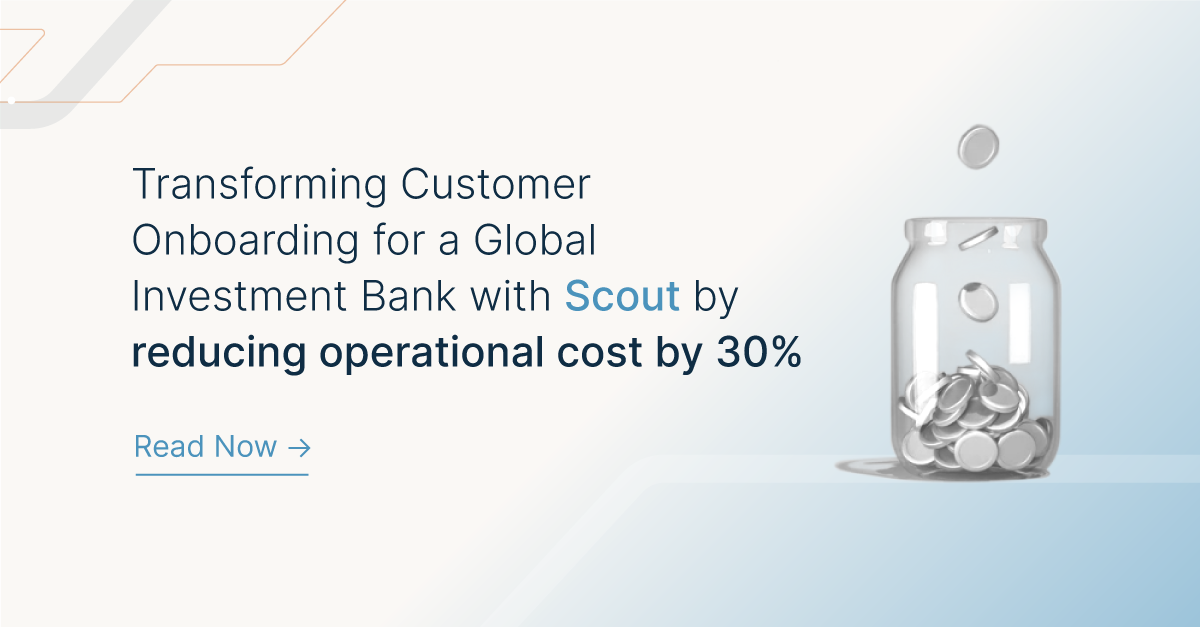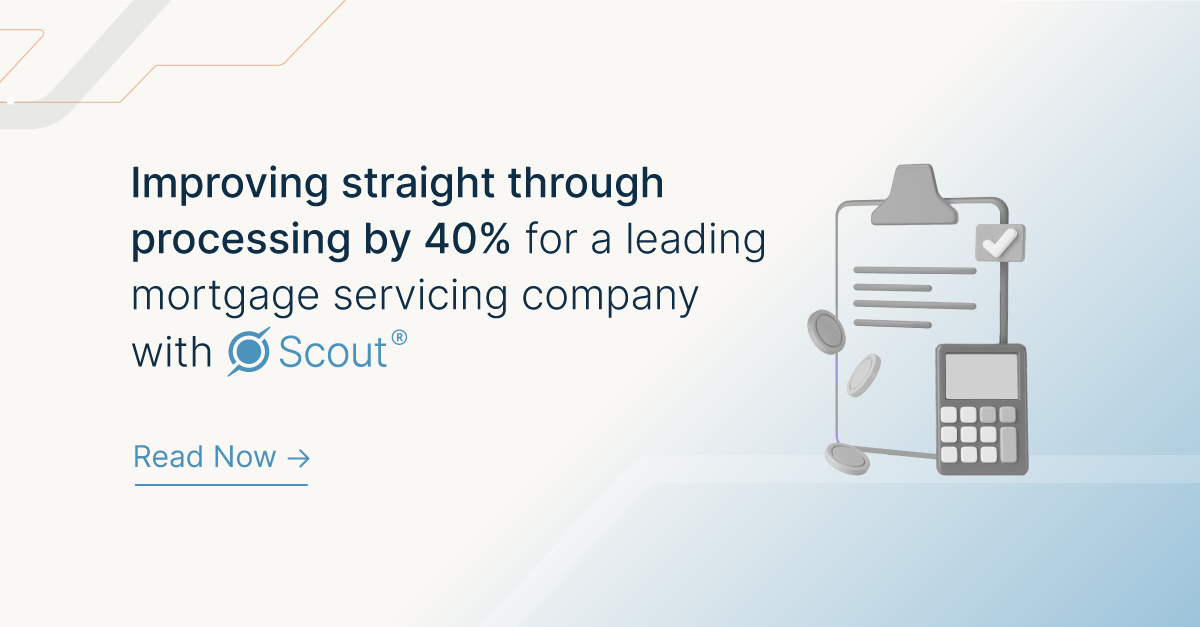Investment Banking Scout transforms customer onboarding for a global investment bank by reducing operational cost by 30% Investment Banking Transforming Customer Onboarding for a Global Investment Bank with Scout by reducing operational cost by 30% The Challenge A leading U.S.-based investment bank aimed to optimize its Global Markets Operations, with a focus on improving customer onboarding and trade settlement processes. The initiative sought to analyze the ‘cost to serve’ for top clients while enhancing the end-to-end customer experience. Industry Investment Banking Location US Attempted Solution before Scout Extensive efforts included conducting interviews, analyzing thousands of customer interactions, and creating 200 dashboards The bank assembled a team of senior associates and consulting partners to develop a sustainable solution. Despite extensive efforts, including interviews, analysis of thousands of customer interactions, and the creation of 200 dashboards, the results were insufficient.The solutions lacked deep insights into critical metrics and failed to provide a comprehensive view of the end-to-end process, leaving essential questions unanswered. Enter The Head of the Global Market Division introduced Scout to provide data-based, near real-time insights into the core business questions. Scout’s AI model could be quickly put into action because it didn’t need complicated integration with current systems. The AI analyzed the ‘cost to serve’ by breaking down total team effort across applications, emails, and documents for each client. It was able to measure this across three metrics: Scout’s AI Model could be quickly put into action because it didn’t need complicated integration with current systems. Responsiveness The speed at which the client receives a response. Seamless experience Assessed by the number of interactions needed per case. Variations Identified client-specific variations or ways in which clients were serviced. Responsiveness the speed at which the client receives a response. Seamless experience assessed by the number ofinteractions needed per case. Variations identified client-specific variations or ways in which clients were serviced. Scout’s AI to “find and fix” Step 1: Find As the first step, the AI decoded the work patterns of the customer onboarding team and connected them to business activities, by analyzing interactions between the onboarding team and their systems. It then automatically classified these work patterns as either core or non-core activities. Harvard Business Review Do You Know How Your Teams Get Work Done? Read more Within two weeks, based on this analysis, Scout’s AI model delivered the following insights: Identified specific pain points, such as the team’s heavy reliance on MS Outlook and Excel. Uncovered an opportunity for email and process automation, which could boost efficiency by nearly 10% through toil reduction. Suggested automating data flow between external websites, spreadsheets, and Outlook, which could further enhance efficiency by 17%. Harvard Business Review How Much Time Does Having Too Many Apps Really Waste? Read more Step 2: Fix Armed with these insights, the management team initiated a series of quick and deep fixes to address the identified issues. Quick Fixes These were ‘no-code’ fixes based on standardisation and user training. Standardization of Data Inputs The management team enforced standardization of data inputs across teams in the Customer Onboarding, Equity Essential Services/Trade (Buy & Sell), Security Settlement, and Prime Brokerage functions. This standardization enabled the generation of new metrics and insights.This fix – Reduced the total effort required to service clients by the Global Market Operations teams and lowered cost to serve per client. Allowed teams to focus on high-impactactivities, better align workforces, and deliver an improved, seamless client experience. Standardization of Reporting Specific reports were developed using Scout data to provide a unified view of effort and touchpoints for each client service request. These reports tracked: Effort spent per client at various lifecycle stages. The number of follow-ups per client. The total effort expended across the entire service process. This standardization allowed for a clearer understanding of resource allocation and client interactions at every stage. Deep Fixes Systemic and long-term fixes planned across the organisation. Scout also provided detailed insights into the cost of unintegrated underwriting systems and applications, as well as the disconnection debt within the organisation. Armed with these insights, the management team initiated a comprehensive transformation program to eliminate, automate, and transition low-impact workloads that delivered minimal value to both clients and the bank. This enabled more effective workload prioritization. Additionally, the customer journey view in Salesforce CRM was enhanced by integrating Scout platform data. This integration provided Client Relationship Managers, Functional Leads, and Leadership with a single source of truth, offering visibility into key metrics and enabling them to monitor the impact of actions and interventions seamlessly. Harvard Business Review What’s Lost When Data Systems Don’t Communicate Read more It is important to note that in all of these recommendations, privacy was of the utmost importance – and no employee data was shared. Empathy was at the core of all recommendations and the focus was on addressing and improving the core issues i.e. Getting teams to work together across functions Fixing disconnected systems Simplifying and optimizing work processes Business outcomes In summary, Scout’s intervention led to significant improvements: 40% Improvement in Turnaround Times: For customer service and requests 30% Reduction in Operational Costs: Streamlining processes and eliminating inefficiencies 15% Enhanced Revenue from Operations: Attributed to increased trade volumes from large customers Elimination of Low-Impact Workloads: Enabling prioritization of high-value tasks How Scout Lit up the “Dark Side of the Moon” Your business generates billions of data points from human-machine interactions. Scout, our AI model, deciphers this interaction data to unveil what often remains unseen—the hidden challenges your teams face at work and how they affect business outcomes, whether it’s cost optimization, revenue growth, customer or employee experience, or business continuity. The AI then provides data-based recommendations for the necessary interventions to address these challenges, paving the way for improved outcomes. We call this lighting up the ‘dark side of the moon’. Forbes The ‘Dark Side Of The Moon’ In Enterprises Read more
Category: Banking
A leading mortgage servicing company improves STP with Scout AI
Banking and Finance Improving straight-through processing by 40% for a leading mortgage servicing company with Scout Email it to me The Challenge A leading mortgage servicing company in the U.S., with 2 subsidiaries and more than 6,000 employees, faced critical challenges in its underwriting function. The workload for lending underwriters varied significantly, leading to overwork, errors, miscalculations, missed SLAs, and, consequently, customer dissatisfaction. These issues adversely affected the company’s reputation in the competitive market. Industry Financial Services Location United States 6,000 Employees 2 Subsidiaries Attempted Solution before Scout About 1,000 hours required from the business teams for discovery workshops The firm appointed a SWAT team to “find and fix this problem,” but their initial solutions fell short. Despite deploying a process mining solution and conducting ‘discovery workshops’ to understand the team’s work patterns, these methods did not provide a comprehensive view of the underlying issues. The extensive time required from the business teams for these workshops—about 1,000 hours—further strained the already overburdened staff, leading to increased stress and attrition. Enter The Head of Process Excellence decided to implement Scout, to find and fix the firm’s challenges. Scout was deployed swiftly, integrating seamlessly without the need for complex adjustments to the existing systems. Scout revealed crucial insights within the first week Scout’s AI to “find and fix” Scout’s AI to “find and fix” Step 1: Find Immediately after deployment, Scout revealed crucial insights within the first week: Only 60% of the underwriters’ time was dedicated to core underwriting tasks. Harvard Business Review Do You Know How Your Teams Get Work Done? Read more The startling statistic that underwriters toggled between applications and documents 800-1,000 times a day, due to unintegrated systems and fragmented data, pointed to a massive work recall gap highlighting the disparity between the team’s understanding of how work is being done and how work was actually being done. The analysis also found a heavy reliance on manual processes and “shadow IT” systems, like Excel spreadsheets, which were inefficient and time-consuming. Harvard Business Review How Much Time Does Having Too Many Apps Really Waste? Read more Step 2: Fix Armed with these insights, the firm quickly implemented targeted solutions: Quick Fixes Training sessions were conducted to elevate the entire team’s performance to the level of the most experienced members A central repository for underwriting calculators and templates was created Deep Fixes The leadership initiated a digital transformation initiative to design an end-to-end workflow system, reducing the disconnection debt by integrating disparate systems and streamlining processes. An intelligent underwriting assistant was also introduced, further enhancing productivity and accuracy. Harvard Business Review What’s Lost When Data Systems Don’t Communicate Read more Business outcomes With Scout’s intervention, the mortgage firm achieved remarkable improvements: Straight-through processing improved by 40% Productivity of lending underwriters increased by 30% Operational costs were reduced by 15% Key operating principles Scout’s deployment was driven by principles that are essential to every success story: Empathy at the Core: It is important to note that in all of these recommendations, privacy was of the utmost importance – and no employee data was shared. Empathy was at the core of all recommendations and the focus was on addressing and improving the core issues i.e., getting teams to work together across functions, fixing disconnected systems, and simplifying and optimizing work processes. Continuous Visibility and Improvement: Scout was an integral part of this transformation, providing continuous visibility and enabling ongoing improvements. How AI connects interaction data to business outcomes Your business generates billions of data points from human-machine interactions. Scout, our AI model, deciphers this interaction data to unveil what often remains unseen—the hidden challenges your teams face at work and how they affect business outcomes, whether it’s cost optimization, revenue growth, customer or employee experience, or business continuity. The AI then provides data-based recommendations for the necessary interventions to address these challenges, paving the way for improved outcomes. We call this lighting up the ‘dark side of the moon’. Forbes The ‘Dark Side Of The Moon’ In Enterprises Read more Download this customer success story Enter Business Email ID
Transforming CX for Asia’s largest private bank with Scout
Retail and Corporate Banking Transforming Customer Experience, and a 30% enhancement in NPS for Asia’s Largest Private Bank with Scout Email it to me The Challenge Asia’s largest private retail bank, with over 8,000 branches and 150,000 employees, was at a crossroads. Faced with fierce competition from digital-first banks, it struggled with missed customer service level agreements (SLAs), high operating costs, and an outdated customer experience framework. The bank handled nearly 10 million customer requests annually, with a significant portion—70% of customer instructions like address changes, contact updates, and new checkbook issuances—being processed manually through its extensive branch network. This not only strained the bank’s resources but also jeopardized its reputation for customer service excellence. Industry Retail and Corporate Banking Location APAC 150,000 Employees 8,000 Branches Attempted Solution before Scout Demanded approximately 3,000 hours to conduct in-depth discovery workshops and interviews The bank’s leadership initiated a digital transformation effort, aiming to overhaul its customer service operations. This included partnering with a Systems Integrator (SI) and deploying traditional process mining tools, which ultimately failed to capture the complete picture of the bank’s operational inefficiencies. Furthermore, attempts to conduct in-depth discovery workshops and interviews to understand team workflows demanded approximately 3,000 hours from the business teams, exacerbating their workload and leading to increased stress and attrition among the staff. Enter In search of a more effective solution, the bank’s Head of Digital Strategy and Banking Operations decided to implement Scout, to find and fix this problem within their Central Processing team. This team was responsible for managing the bulk of the customer service requests, numbering around 1 million annually. Scout’s deployment was swift and seamless, requiring no intricate integration with the bank’s existing systems and fully adhering to the strictest data security and privacy standards. Within just 2 weeks of deployment Scout’s analysis unearthed several critical insights Scout’s AI to “find and fix” Scout’s AI to “find and fix” Step 1: Find Scout’s analysis unearthed several critical insights within just two weeks of deployment: A significant discovery was that 80% of branch requests were not related to debit cards, indicating a potential area for enhancing digital self-service options. Another alarming issue was that 70% of the requests handled by the central processing unit were placed on hold due to incomplete or incorrect information from the branches. Harvard Business Review Do You Know How Your Teams Get Work Done? Read more The analysis also showed that the team spent about 30% of their time toggling between the core banking application and the document tracking system, leading to inefficiencies and delays. This startling statistic pointed to a massive work recall gap across the team, highlighting the disparity between the team’s understanding of how work is being done and how work was actually being done. Harvard Business Review How Much Time Does Having Too Many Apps Really Waste? Read more Step 2: Fix Armed with Scout’s insights, the bank swiftly implemented several quick and deep fixes: Quick Fixes Enhancements to the net banking and mobile app interfaces for non-debit card related services were rolled out Increased marketingefforts to promote digital channel usage Enhancements to the net banking and mobile app interfaces for non-debit card related services were rolled out Deep Fixes The bank initiated a project to integrate the core banking system with the form tracking system, reducing the need for manual toggling and to reduce the disconnection debt. It also developed a combined cognitive automation and OCR-based solution for the service request workflow, significantly improving straight-through processing rates. Harvard Business Review What’s Lost When Data Systems Don’t Communicate Read more It is important to note that in all of these recommendations, privacy was of the utmost importance – and no employee data was shared. Empathy was at the core of all recommendations and the focus was on addressing and improving the core issues i.e. Getting teams to work together across functions Fixing disconnected systems Simplifying and optimizing work processes Business outcomes In summary, Scout was able to drive the following business outcomes 30% improvement in end-customer NPS 20% reduction in operational costs, streamlining the bank’s expenses 80% improvement in straight-through processing of customer instructions, demonstrating the efficiency gains from the implemented solutions. AI connects interaction data to business outcomes Scout lights up the ‘dark side of the moon’. Your business generates billions of data points from team-machine interactions. Scout, our AI model, deciphers this interaction data to reveal what often remains unseen—the hidden challenges your teams face at work and how they affect business outcomes, whether it’s cost optimization, revenue growth, customer or employee experience, or business continuity. The AI then provides data-based recommendations to address these challenges, paving the way for improved outcomes. Forbes The ‘Dark Side Of The Moon’ In Enterprises Read more Download this customer success story Enter Business Email ID


